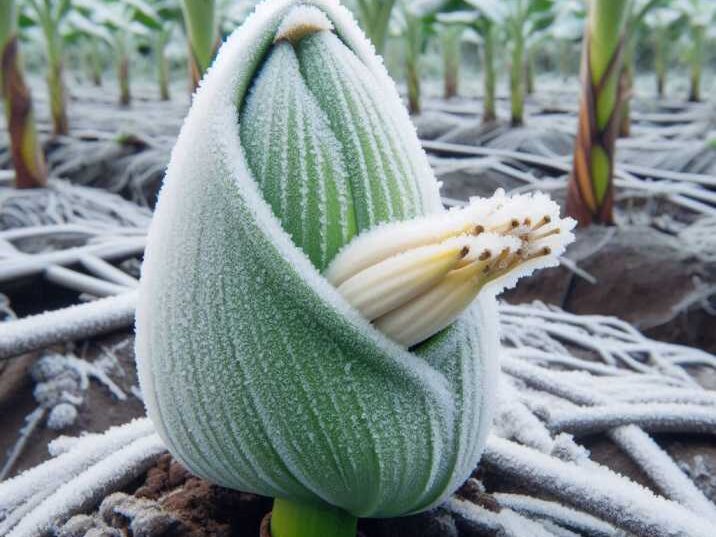Banana plants thrive in warm, tropical climates, but what if you’re trying to grow baby banana plants in a colder region? Frost can devastate these delicate plants, especially young ones that are still developing. This article explores effective methods to Prevent Frost Damage to Baby Banana Plants from frost damage, ensuring they can survive and flourish even in colder environments. This guide will be easy to follow, full of helpful tips, and perfect for young readers learning about plant care.

Introduction
Table of Contents
Bananas are often associated with warm, sunny weather, but some adventurous gardeners love the challenge of growing banana plants in colder climates. While adult banana plants can sometimes handle a bit of chill, baby banana plants are especially vulnerable to frost. These young plants are still establishing their roots and growing, which makes them more sensitive to temperature drops. If you’re growing banana plants and the forecast predicts a cold night, don’t worry! You can take several steps to protect your banana plants from frost damage.
How Frost Affects Baby Banana Plants
Frost can have a harmful effect on baby banana plants. These young plants have tender leaves and stems that are easily damaged by freezing temperatures. Frost forms when temperatures drop below 32°F (0°C), and this icy layer can cause the cells in the plant to freeze, leading to tissue damage. For baby banana plants, this could mean stunted growth, or, in severe cases, the plant might not survive.
When exposed to frost, banana plants may exhibit the following signs:
- Leaf discoloration (often brown or black)
- Droopy or wilted leaves
- Soft and mushy stems
Taking action before cold weather hits is important to prevent frost damage.
Tips for Preventing Frost Damage to Baby Banana Plants
1. Choose Cold-Hardy Banana Varieties
Some banana varieties are more resistant to cold temperatures than others. If you’re growing baby banana plants in colder climates, consider planting cold-hardy varieties such as:
- Musa basjoo: Known as the hardy banana, this variety can survive freezing temperatures with the right protection.
- Dwarf Cavendish: While not as hardy as Musa basjoo, this variety can tolerate cooler conditions better than others.
These varieties are more likely to withstand occasional frost, making your job a little easier.
2. Plant in the Right Location
The location where you plant your banana trees can play a big role in preventing frost damage. Here are some tips to keep in mind:
- South-facing slopes tend to get more sunlight during the day, helping to keep plants warmer.
- Avoid low areas where cold air can settle.
- Shelter plants from wind, as cold winds can make frost damage worse.
3. Mulching for Insulation
Mulching is one of the easiest and most effective ways to protect baby banana plants from frost. Mulch acts like a blanket, keeping the soil warm and insulating the plant’s roots. Use organic materials such as:
- Straw
- Pine needles
- Shredded leaves
Apply a thick layer of mulch around the plant’s base, ensuring it covers the root zone.

4. Watering Before Frost
Watering your baby banana plants before a frost can help prevent damage. Moist soil holds heat better than dry soil, so watering the plants in the afternoon can help the soil retain more warmth at night.
5. Covering Your Plants
Covering your baby banana plants can protect them from freezing temperatures when frost is expected. Use materials such as:
- Frost blankets
- Old sheets
- Burlap
Ensure the cover reaches the ground to trap warmth and secure it so it doesn’t blow away in the wind. Remove the cover during the day to allow the plant to get sunlight.
Additional Techniques for Frost Protection
1. Move Potted Banana Plants Indoors
If you’re growing baby banana plants in pots, you have the advantage of being able to move them. When frost is in the forecast, simply move the plants to a warmer location, such as a garage or inside your home. This protects the plant from frost exposure and ensures its survival.
2. Using Heat Lamps or Heaters
For outdoor plants, you can use heat lamps or outdoor heaters to keep the air around the plants warmer. Just be sure to position the heat source safely away from the plant to avoid scorching the leaves.
3. Windbreaks
Creating a windbreak can help protect your baby banana plants from cold winds that can worsen frost damage. You can use:
- Fencing
- Shrubs
- Temporary screens
These barriers reduce wind exposure and help maintain warmer temperatures around your plants.
Table of Information: Frost Protection for Baby Banana Plants
| Method | Description | Effectiveness |
|---|---|---|
| Cold-Hardy Varieties | Planting bananas that can tolerate cooler temperatures | High |
| Mulching | Insulates the roots to keep them warm | Moderate to High |
| Covering with Frost Blankets | Protects the plant from direct exposure to frost | High |
| Moving Potted Plants Indoors | Safely removes the plant from cold conditions | Very High |
| Using Heat Lamps or Heaters | Adds warmth to the area around the plant | High |
Conclusion
While growing baby banana plants in colder climates can be challenging, it’s not impossible! You can protect your plants from frost damage by selecting the right banana varieties, providing mulch and proper cover, and moving plants indoors or using additional heat when necessary. Whether you’re a seasoned gardener or just starting out, these tips will help your banana plants survive and thrive, even when the temperatures drop.
FAQs About Prevent Frost Damage to Baby Banana Plants
1. How cold is too cold for baby banana plants?
Without protection, most baby banana plants cannot survive temperatures below 32°F (0°C).
2. Can baby banana plants survive a light frost?
Yes, they can survive a light frost with proper protection like mulching and covering.
3. Should I water my banana plants before a frost?
Yes, watering the plants before a frost can help the soil retain heat and protect the roots.
4. What type of mulch works best for frost protection?
Straw, pine needles, and shredded leaves are great options for insulating baby banana plants.
5. Can I use plastic to cover my banana plants during frost?
It’s best to avoid plastic, as it can trap moisture and freeze, causing more harm. Use fabric covers instead.
